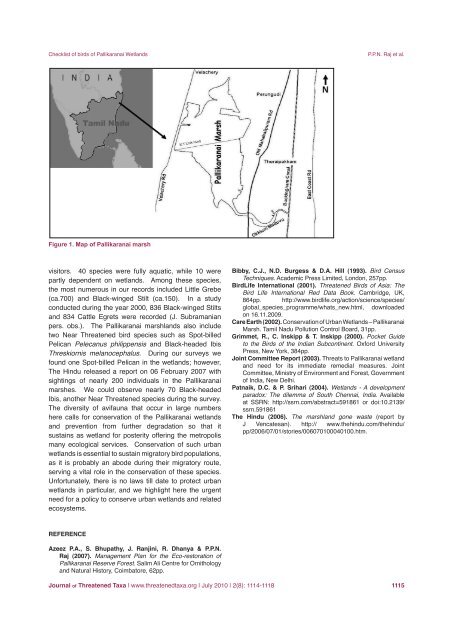Consolidated checklist of birds in the Pallikaranai Wetlands ...
Consolidated checklist of birds in the Pallikaranai Wetlands ...
Consolidated checklist of birds in the Pallikaranai Wetlands ...
Create successful ePaper yourself
Turn your PDF publications into a flip-book with our unique Google optimized e-Paper software.
Checklist <strong>of</strong> <strong>birds</strong> <strong>of</strong> <strong>Pallikaranai</strong> <strong>Wetlands</strong>P.P.N. Raj et al.Figure 1. Map <strong>of</strong> <strong>Pallikaranai</strong> marshvisitors. 40 species were fully aquatic, while 10 werepartly dependent on wetlands. Among <strong>the</strong>se species,<strong>the</strong> most numerous <strong>in</strong> our records <strong>in</strong>cluded Little Grebe(ca.700) and Black-w<strong>in</strong>ged Stilt (ca.150). In a studyconducted dur<strong>in</strong>g <strong>the</strong> year 2000, 836 Black-w<strong>in</strong>ged Stiltsand 834 Cattle Egrets were recorded (J. Subramanianpers. obs.). The <strong>Pallikaranai</strong> marshlands also <strong>in</strong>cludetwo Near Threatened bird species such as Spot-billedPelican Pelecanus philippensis and Black-headed IbisThreskiornis melanocephalus. Dur<strong>in</strong>g our surveys wefound one Spot-billed Pelican <strong>in</strong> <strong>the</strong> wetlands; however,The H<strong>in</strong>du released a report on 06 February 2007 withsight<strong>in</strong>gs <strong>of</strong> nearly 200 <strong>in</strong>dividuals <strong>in</strong> <strong>the</strong> <strong>Pallikaranai</strong>marshes. We could observe nearly 70 Black-headedIbis, ano<strong>the</strong>r Near Threatened species dur<strong>in</strong>g <strong>the</strong> survey.The diversity <strong>of</strong> avifauna that occur <strong>in</strong> large numbershere calls for conservation <strong>of</strong> <strong>the</strong> <strong>Pallikaranai</strong> wetlandsand prevention from fur<strong>the</strong>r degradation so that itsusta<strong>in</strong>s as wetland for posterity <strong>of</strong>fer<strong>in</strong>g <strong>the</strong> metropolismany ecological services. Conservation <strong>of</strong> such urbanwetlands is essential to susta<strong>in</strong> migratory bird populations,as it is probably an abode dur<strong>in</strong>g <strong>the</strong>ir migratory route,serv<strong>in</strong>g a vital role <strong>in</strong> <strong>the</strong> conservation <strong>of</strong> <strong>the</strong>se species.Unfortunately, <strong>the</strong>re is no laws till date to protect urbanwetlands <strong>in</strong> particular, and we highlight here <strong>the</strong> urgentneed for a policy to conserve urban wetlands and relatedecosystems.Bibby, C.J., N.D. Burgess & D.A. Hill (1993). Bird CensusTechniques. Academic Press Limited, London, 257pp.BirdLife International (2001). Threatened Birds <strong>of</strong> Asia: TheBird Life International Red Data Book. Cambridge, UK,864pp. http://www.birdlife.org/action/science/species/global_species_programme/whats_new.html, downloadedon 16.11.2009.Care Earth (2002). Conservation <strong>of</strong> Urban <strong>Wetlands</strong> – <strong>Pallikaranai</strong>Marsh. Tamil Nadu Pollution Control Board, 31pp.Grimmet, R., C. Inskipp & T. Inskipp (2000). Pocket Guideto <strong>the</strong> Birds <strong>of</strong> <strong>the</strong> Indian Subcont<strong>in</strong>ent. Oxford UniversityPress, New York, 384pp.Jo<strong>in</strong>t Committee Report (2003). Threats to <strong>Pallikaranai</strong> wetlandand need for its immediate remedial measures. Jo<strong>in</strong>tCommittee, M<strong>in</strong>istry <strong>of</strong> Environment and Forest, Government<strong>of</strong> India, New Delhi.Patnaik, D.C. & P. Srihari (2004). <strong>Wetlands</strong> - A developmentparadox: The dilemma <strong>of</strong> South Chennai, India. Availableat SSRN: http://ssrn.com/abstract=591861 or doi:10.2139/ssrn.591861The H<strong>in</strong>du (2006). The marshland gone waste (report byJ Vencatesan). http:// www.<strong>the</strong>h<strong>in</strong>du.com/<strong>the</strong>h<strong>in</strong>du/pp/2006/07/01/stories/006070100040100.htm.ReferenceAzeez P.A., S. Bhupathy, J. Ranj<strong>in</strong>i, R. Dhanya & P.P.N.Raj (2007). Management Plan for <strong>the</strong> Eco-restoration <strong>of</strong><strong>Pallikaranai</strong> Reserve Forest. Salim Ali Centre for Ornithologyand Natural History, Coimbatore, 62pp.Journal <strong>of</strong> Threatened Taxa | www.threatenedtaxa.org | July 2010 | 2(8): 1114-11181115
















